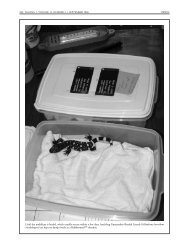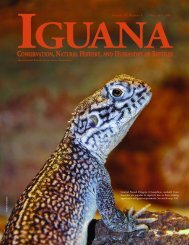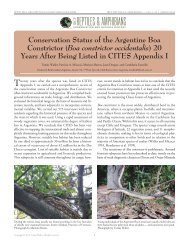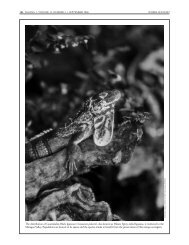Spiny-tailed Iguanas (Ctenosaura similis) in Venezuela
Spiny-tailed Iguanas (Ctenosaura similis) in Venezuela
Spiny-tailed Iguanas (Ctenosaura similis) in Venezuela
Create successful ePaper yourself
Turn your PDF publications into a flip-book with our unique Google optimized e-Paper software.
ROBERT POWELL<br />
132 IGUANA • VOLUME 15, NUMBER 3 • SEPTEMBER 2008 DANIELLS ET AL.<br />
Frogs (Amphibia: Anura)<br />
Eleutherodactylus ampl<strong>in</strong>ympha (Kaiser, Green, and Schmid<br />
1994). Anura: Eleutherodactylidae. Local name: Dom<strong>in</strong>ican<br />
Gounouj. English common names: Dom<strong>in</strong>ican Frog,<br />
Dom<strong>in</strong>ican Ra<strong>in</strong> Frog, Dom<strong>in</strong>ican Whistl<strong>in</strong>g Frog. Endemic.<br />
These relatively small frogs (maximum male SVL 26 mm, maximum<br />
female SVL 50 mm) occur at elevations >300 m <strong>in</strong> montane<br />
ra<strong>in</strong> forest, where they perch on trees, palm brakes, moss<br />
mats, epiphytes, and ferns. This species has a po<strong>in</strong>ted snout and<br />
relatively large toepads. Males have bi-lobed glandular vocal sacs<br />
and produce a three-note call. Dorsal color varies from brownish<br />
to greenish to reddish, and, as <strong>in</strong> other frogs <strong>in</strong> the genus,<br />
pattern elements are highly variable. These largely nocturnal<br />
frogs are known to call by day <strong>in</strong> wet forests dur<strong>in</strong>g or after<br />
heavy ra<strong>in</strong>s. The species is <strong>in</strong>cluded on the IUCN Red List as<br />
“endangered,” primarily due to its restricted range, high likelihood<br />
of habitat loss attributable to human expansion, volcanism,<br />
or hurricanes, and the potential threat posed by chytridiomycosis,<br />
a fungal <strong>in</strong>fection to which upland amphibians <strong>in</strong> the<br />
tropics appear to be particularly vulnerable.<br />
The endangered Dom<strong>in</strong>ican Frog (Eleutherodactylus ampl<strong>in</strong>ympha) is<br />
restricted to moist forests at higher elevations.<br />
Eleutherodactylus johnstonei (Barbour 1914). Anura:<br />
Eleutherodactylidae. No local name. English common names:<br />
Lesser Antillean Frog, Johnstone’s Whistl<strong>in</strong>g Frog, Johnstone’s<br />
Robber Frog. Lesser Antillean endemic, <strong>in</strong>troduced on<br />
Dom<strong>in</strong>ica, other West Indian islands, and the South American<br />
ma<strong>in</strong>land. These frogs are thought to have been <strong>in</strong>troduced on<br />
Dom<strong>in</strong>ica after Hurricane David <strong>in</strong> 1979, probably with relief<br />
supplies from neighbor<strong>in</strong>g islands. Throughout their extended<br />
range, these small frogs (maximum male SVL 25 mm, maximum<br />
female SVL 35 mm) thrive <strong>in</strong> artificial sites such as residential<br />
gardens, agricultural areas, roadsides, and build<strong>in</strong>gs from<br />
sea level to elevations of ~1300 m. This species has a rounded<br />
snout and relatively small toepads. Males have a s<strong>in</strong>gle-lobed<br />
glandular vocal sac and produce a two-note call. Dorsal ground<br />
color usually is some shade of brown; other mark<strong>in</strong>gs are highly<br />
variable. Where the two species occur together, E. johnstonei<br />
often is confused with closely related E. mart<strong>in</strong>icensis.<br />
Eleutherodactylus johnstonei is a nocturnally active sit-and-wait<br />
predator with a diet composed primarily of small arthropods.<br />
Documented predators <strong>in</strong>clude Turnip-<strong>tailed</strong> Geckos<br />
(Thecadactylus rapicauda) and snakes. Recent surveys have failed<br />
The Lesser Antillean Frog (Eleutherodactylus johnstonei) has been<br />
recorded from Dom<strong>in</strong>ica. Although it has successfully colonized other<br />
islands, where it has displaced native species, it has not been found dur<strong>in</strong>g<br />
recent surveys, suggest<strong>in</strong>g that the colonization of Dom<strong>in</strong>ica has<br />
failed. This frog was photographed on St. V<strong>in</strong>cent.<br />
to document the presence of this species on Dom<strong>in</strong>ica and it is<br />
no longer <strong>in</strong>cluded <strong>in</strong> the list of Dom<strong>in</strong>ican amphibians. This<br />
species is <strong>in</strong>cluded on the IUCN Red List as be<strong>in</strong>g of “least concern,”<br />
largely attributable to its coloniz<strong>in</strong>g ability, which is<br />
unusual among amphibians, which generally have little tolerance<br />
for exposure to saltwater. Introduced populations on some<br />
islands compete successfully with native species, and often displace<br />
them, especially from altered habitats.<br />
Eleutherodactylus mart<strong>in</strong>icensis (Tschudi 1838). Anura:<br />
Eleutherodactylidae. Local name: T<strong>in</strong>k Frog. English common<br />
names: Mart<strong>in</strong>ique Frog, Mart<strong>in</strong>ique Robber Frog. This Lesser<br />
Antillean endemic is presumably native on Dom<strong>in</strong>ica, although<br />
it may have been imported <strong>in</strong>advertently by early European settlers.<br />
These small frogs (maximum male SVL 32 mm, maximum<br />
female SVL 47 mm) occur from sea level to at least 1,250 m <strong>in</strong><br />
varied natural and altered habitats that <strong>in</strong>clude ra<strong>in</strong> forests, dry<br />
woodlands, banana and coconut plantations, and gardens. This<br />
species has a po<strong>in</strong>ted snout and relatively small toepads. Males<br />
have a bi-lobed glandular vocal sac and produce a two-note call.<br />
Dorsal color is brownish to reddish; other mark<strong>in</strong>gs are highly<br />
variable. These nocturnal frogs may call by day dur<strong>in</strong>g or after<br />
Like many relatives, patterns of Mart<strong>in</strong>ique Frogs (Eleutherodactylus<br />
mart<strong>in</strong><strong>in</strong>censis) are highly variable. This <strong>in</strong>dividual has a fa<strong>in</strong>t middorsal<br />
l<strong>in</strong>e, but others may be unicolored, blotched, or have very dist<strong>in</strong>ct<br />
dorsal “rac<strong>in</strong>g” stripes.<br />
ROBERT POWELL<br />
ROBERT POWELL








